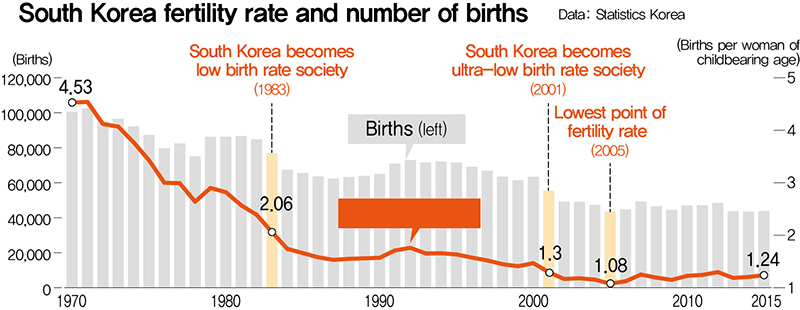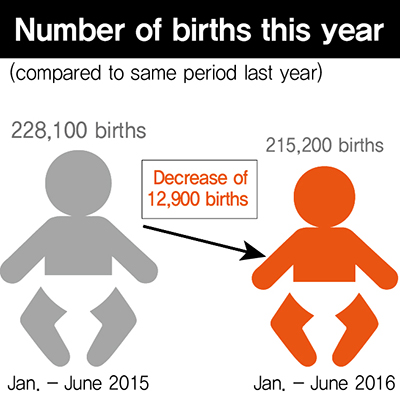 |
|
South Korea fertility rate and number of births. Data: Statistics Korea
|
Government’s many measures have had little effect on raising the low birthrate
The reason the South Korean government has been left resorting to public “appeals” to overcome the low birth rate crisis stems from the fact that the rate has remained stagnant despite various measures to raise it over the years. The total fertility rate for women of childbearing age (15 to 49) stood at 4.53 in 1970. It fell steeply through the 1970s and 1980s before hitting rock bottom at 1.08 in 2005. While it hasn’t fallen any further since then, it also has shown almost no rebound in the ten years since. Last year, the South Korean birth rate was just 1.24. In terms of numbers of newborns, the decline has also been dramatic: from one million in 1970 to 438,000 last year. As of 2014, South Korea registered the lowest birth rate among Organisation for Economic Co-operation and Development (OECD) member countries.
 |
|
Number of births this year
|
Maintaining the current population would require a replacement birth rate of 2.1. Countries that fail to achieve this level are called “low-birth rate societies”; those with a rate below 1.3 are called “ultra-low birth rate societies.” South Korea was already considered a low-birth rate society by 1983, but it was not until 2005 that it began vigorously pursuing measures to raise the birth rate. Since then, administrations have come out with measures to combat the low birth rate every five years – but the young couples who would be having the children are feeling little effect from them.In addition to number of newborns, declines have been occurring for most major indicators for low birth rate. The number of marriages between Jan. and May 2016 was down by 9,000 from the same period the year before. Employment conditions have failed to improve for young people, with the youth unemployment rate rising year after year (10.3% as of June). The number of women aged 25 to 39 – considered the most likely to have children – fell from 6.25 million in 2005 to 5.26 million last year.In announcing its third framework plan in Dec. 2015, Seoul set a total fertility rate target of 1.5 by 2020. Initially, it had pledged measures to increase the number of newborns this year to 445,000. The plan was to increase births by around 8,000 per year to reach the target of a birth rate of 1.5. But experts warn that with little impact perceived from the current measures, the number of births could drop below what has been called the “Maginot line” of 400,000.
By Hwangbo Yon and Noh Hyun-woong, staff reportersPlease direct questions or comments to [english@hani.co.kr]
